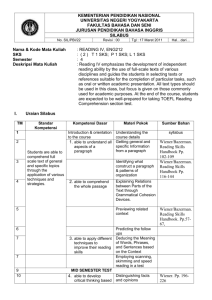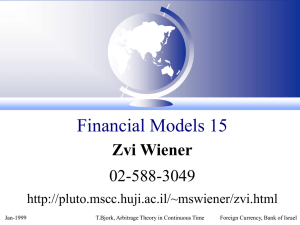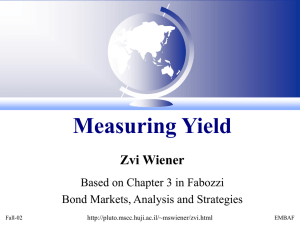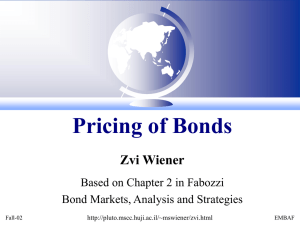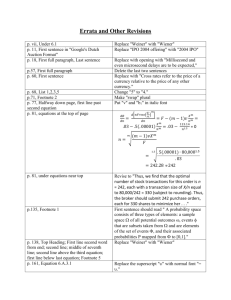Zvi Wiener
advertisement
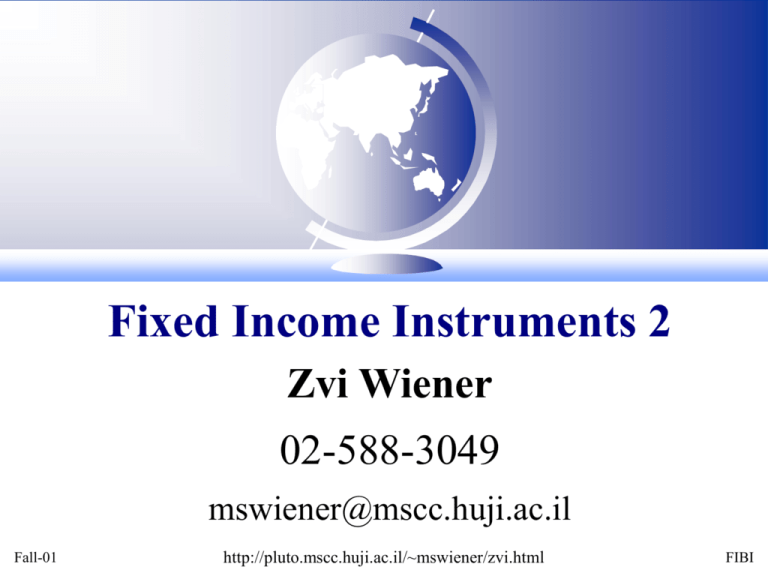
Fixed Income Instruments 2 Zvi Wiener 02-588-3049 mswiener@mscc.huji.ac.il Fall-01 http://pluto.mscc.huji.ac.il/~mswiener/zvi.html FIBI Plan FI-2 • Example of Duration and Convexity • Treasuries • Agencies • Corporate • Municipals The Treasury Securities Markets: Overview and Recent Developments, by D. Dupont and B. Sack, Federal Reserve Bulletin, Dec-99. Zvi Wiener FIFIBI - 2 slide 2 Example Portfolio consists of $1M of a bond with duration of 1 year and $1M worth of a bond with duration of 20 years. What is the duration of the portfolio? Zvi Wiener FIFIBI - 2 slide 3 Rough calculation Duration of the first bond is 1 year, of the second bond is 20 years. This means that when IR go 1% up we will lose 1% of the first bond and 20% of the second. All together we will lose 10.5% of the portfolio. The duration is (roughly) 10.5 years. Zvi Wiener FIFIBI - 2 slide 4 Value 1.05 1.07 20 1.05 1.07 20 2 20 20 1 r1 1 r20 1 0.05 1 0.07 2.8 value 2.6 2.4 2.2 Parallel shift -0.03 -0.02 -0.01 0.01 0.02 0.03 1.8 1.6 Zvi Wiener FIFIBI - 2 slide 5 Duration 1 1 20 9.8212 2 1.05 1.07 1 dA DA A dr D A B ADA BD B A B A B 1 d 1.05 1.07 20 20 2 dx 1 r1 x 1 r20 x Zvi Wiener FIFIBI - 2 9.8212 x 0 slide 6 Convexity 2 d A CA 2 dr 20 d 1.05 1.07 368 20 2 dx 1 r1 x 1 r20 x x 0 2 For a simple bond portfolio it does not help much! It is much more important to consider 2 risk factors! Zvi Wiener FIFIBI - 2 slide 7 Portfolio 2 Time 0 1 Money +1 Term Structure 5% value 5 20 -2 6% +2 7% 1 2 2 0.025 5 20 1.05 1.06 1.07 Assets duration = 7.19 Liabilities duration = 4.7169 Zvi Wiener FIFIBI - 2 slide 8 8% Coupon Bond Yield to Maturity 8% 9% Price Change T=1 yr. T=10 yr. T=20 yr. 1,000.00 1,000.00 1,000.00 990.64 934.96 907.99 0.94% 6.50% 9.20% Zero Coupon Bond Yield to Maturity 8% 9% Price Change Zvi Wiener T=1 yr. T=10 yr. T=20 yr. 924.56 456.39 208.29 915.73 414.64 171.93 0.96% 9.15% 17.46% FIFIBI - 2 slide 9 Macaulay Duration (1) (2) (3) (4) (5) Time until Payment column (1) payment Payment Discounted Weight multiplied (in Years) at 5% by (4) Bond A 8% 0.5 1.0 1.5 2.0 $40 $40 $40 $1,040 $38.095 $36.281 $34.553 $855.611 $964.540 0.0395 0.0376 0.0358 0.8871 1.000 0.0198 0.0376 0.0537 1.7742 1.8853 0.5-1.5 2.0 0 $1,000 $0 $822.70 $822.70 0 1 1 0 2 2 Sum: Bond B zero Sum Zvi Wiener FIFIBI - 2 slide 10 Understanding of Duration/Convexity What happens with duration when a coupon is paid? How does convexity of a callable bond depend on interest rate? How does convexity of a puttable bond depend on interest rate? Zvi Wiener FIFIBI - 2 slide 11 Callable bond The buyer of a callable bond has written an option to the issuer to call the bond back. Rationally this should be done when … Interest rate fall and the debt issuer can refinance at a lower rate. Zvi Wiener FIFIBI - 2 slide 12 Puttable bond The buyer of a such a bond can request the loan to be returned. The rational strategy is to exercise this option when interest rates are high enough to provide an interesting alternative. Zvi Wiener FIFIBI - 2 slide 13 Embedded Call Option regular bond strike callable bond r Zvi Wiener FIFIBI - 2 slide 14 Embedded Put Option putable bond regular bond r Zvi Wiener FIFIBI - 2 slide 15 Convertible Bond Payoff Convertible Bond Stock Straight Bond Stock Zvi Wiener FIFIBI - 2 slide 16 Timing of exercise • European • American • Bermudian • Lock up time Zvi Wiener FIFIBI - 2 slide 17 Passive Bond Management Passive management takes bond prices as fairly set and seeks to control only the risk of the fixed-income portfolio. • Indexing strategy – attempts to replicate a bond index • Immunization – used to tailor the risk to specific needs (insurance companies, pension funds) Zvi Wiener FIFIBI - 2 slide 18 Bond-Index Funds Similar to stock indexing. Major indices: Lehman Brothers, Merill Lynch, Salomon Brothers. Include: government, corporate, mortgagebacked, Yankee bonds (dollar denominated, SEC registered bonds of foreign issuers, sold in the US). Zvi Wiener FIFIBI - 2 slide 19 Bond-Index Funds Properties: many issues not all are liquid replacement of maturing issues Tracking error is a good measurement of performance. According to Salomon Bros. With $100M one can track the index within 4bp. tracking error per month. Zvi Wiener FIFIBI - 2 slide 20 Cellular approach ttm\Sector Treasury Agency MBS < 1yr 12.1% 1-3 yrs 5.4% 4.1% 3.2% 3-5 yrs 9.2% 6.1% Zvi Wiener FIFIBI - 2 slide 21 Immunization Immunization techniques refer to strategies used by investors to shield their overall financial status from exposure to interest rate fluctuations. Zvi Wiener FIFIBI - 2 slide 22 Net Worth Immunization Banks and thrifts have a natural mismatch between assets and liabilities. Liabilities are primarily short-term deposits (low duration), assets are typically loans or mortgages (higher duration). When will banks lose money, when IR increase or decline? Zvi Wiener FIFIBI - 2 slide 23 Gap Management ARM are used to reduce duration of bank portfolios. Other derivative securities can be used. Capital requirement on duration (exposure). Basic idea: to match duration of assets and liabilities. Zvi Wiener FIFIBI - 2 slide 24 Target Date Immunization Important for pension funds and insurances. Price risk and reinvestment risk. What is the correlation between them? Zvi Wiener FIFIBI - 2 slide 25 Target Date Immunization Accumulated value Original plan 0 Zvi Wiener t* t FIFIBI - 2 slide 26 Target Date Immunization Accumulated value IR increased at t* 0 Zvi Wiener t* t FIFIBI - 2 slide 27 Target Date Immunization Accumulated value 0 Zvi Wiener t* D FIFIBI - 2 t slide 28 Target Date Immunization Accumulated value 0 Zvi Wiener Continuous rebalancing can keep the terminal value unchanged t* D FIFIBI - 2 t slide 29 Good Versus Bad Immunization value $10,000 Single payment obligation 0 Zvi Wiener 8% FIFIBI - 2 r slide 30 Good Versus Bad Immunization value Good immunizing strategy $10,000 Single payment obligation 0 Zvi Wiener 8% FIFIBI - 2 r slide 31 Good Versus Bad Immunization value Good immunizing strategy $10,000 Single payment obligation 0 Zvi Wiener 8% FIFIBI - 2 r slide 32 Good Versus Bad Immunization value Bad immunizing strategy Good immunizing strategy $10,000 Single payment obligation 0 Zvi Wiener 8% FIFIBI - 2 r slide 33 Standard Immunization Is very useful but is based on the assumption of the flat term structure. Often a higher order immunization is used (convexity, etc.). Another reason for goal oriented mutual funds (retirement, education, housing, medical expenses). Zvi Wiener FIFIBI - 2 slide 34 Cash Flow Matching and Dedication Is a very reasonable strategy, but not always realizable. Uncertainty of payments. Lack of perfect match Saving on transaction fees. Zvi Wiener FIFIBI - 2 slide 35 Active Bond Management Mainly speculative approach based on ability to predict IR or credit enhancement or market imperfections (identifying mispriced loans). Zvi Wiener FIFIBI - 2 slide 36 Substitution Swap Exchange of one bond for a very similar bond. Motivation: belief that one of them is mispriced. Example: 20-yr, 9% coupon Ford Motor bond callable after 5 years at $1,050 versus a 9% coupon Chrysler bond with 20 yr to maturity. Zvi Wiener FIFIBI - 2 slide 37 Contingent Immunization value $12,000 $10,000 0 Zvi Wiener 5 yr t FIFIBI - 2 slide 38 Contingent Immunization value $12,000 $10,000 Stop boundary 0 Zvi Wiener 5 yr t FIFIBI - 2 slide 39 Contingent Immunization value $12,000 $10,000 Stop boundary 0 Zvi Wiener 5 yr t FIFIBI - 2 slide 40 Contingent Immunization value $12,000 $10,000 Stop boundary 0 Zvi Wiener 5 yr t FIFIBI - 2 slide 41 Interest Rate Swap One of the major fixed-income tools. Example: 6m LIBOR versus 7% fixed. Exchange of net cash flows. Risk involved: IR risk, default risk (small). Why the default risk on IR swaps is small? Zvi Wiener FIFIBI - 2 slide 42 Interest Rate Swap 7.05% 6.95% Company B Swap dealer Company A LIBOR LIBOR No need in an actual loan. Can be used as a speculative tool or for hedging. Zvi Wiener FIFIBI - 2 slide 43 Currency Swap A similar exchange of two loans in different currencies. Subject to a higher default risk, because of the principal. Is useful for international companies to hedge currency risk. Zvi Wiener FIFIBI - 2 slide 44 The Treasuries Securities Market US Treasury debt $3.6Trillion daily transactions: $190B yields are viewed as benchmarks 1776, first US issue (Revolutionary War) Increase during the Civil war, WW1, tripled during the great depression exploded during WW2. Zvi Wiener FIFIBI - 2 slide 45 Types of Treasuries securities • $3.2T - marketable – Bills - up to one year – Notes 1-10 years when issued – Bonds longer then 10 years • 57% are notes, 20% bills and 20% bonds. • Some are callable (by the Treasury) • 97% are nominal Zvi Wiener FIFIBI - 2 slide 46 Nonmarketable securities • Government account series (83%) • State and Local Government Series (7%) • saving bonds (7%) held by off-budget government programs, like social security, local governments, etc. yield is at least 5bp below marketable Treasuries. Zvi Wiener FIFIBI - 2 slide 47 Issuance of Treasuries • regularly scheduled auctions = primary market. • 2,000 brokers and dealers are registered • Prime dealers are selected by NY Fed counterparites for open market operations. Zvi Wiener FIFIBI - 2 slide 48 Auctions • The process begins several days before. • “when issued market” after the announcement but before it takes place. • On the day of the auctions bids may be submitted to FED. • Competitive bids - quantity and yield • Noncompetitive bids - small orders Zvi Wiener FIFIBI - 2 slide 49 Auctions • Uniform price method for 2, 5 year notes, TIPS • Other issues have multiple price auction • Bidders get securities at their bid price. • Non-competitive get at the average price of competitive bids. Zvi Wiener FIFIBI - 2 slide 50 Auctions • $6.5B of 13-week bills and $7.5B of 26 week bills - weekly • $10B of 52 week bills - every four weeks • $15B of 2-year notes, every 4 weeks • $12B of ten -year notes and $10B of 30 years bonds - semiannually. • Sometimes an old issue may be reopen. Zvi Wiener FIFIBI - 2 slide 51 Cancellations 1986 20 year bond 1990 4 year note 1993 7 year note 1998 3 year note Zvi Wiener FIFIBI - 2 slide 52 Market Primarily OTC (over the counter) market. Officially registered at NYSE, but volume is negligible. Market makers in Treasuries - bid-offer spread. Six primary dealers - 50% of trades (22 hr/day). 94% - NY, 4% - London, 2% Tokyo. Zvi Wiener FIFIBI - 2 slide 53 Quoting conventions Coupon securities are quoted in terms of price expressed in dollars. Clean price excludes accrued interest. Accrued interest = next coupon*fraction of time that passed. Bills are quoted in terms of discount rate as % of face value. Assuming 360 days in a year, i.e. multiplied by 360 and divided by the actual number of days remaining to maturity. Zvi Wiener FIFIBI - 2 slide 54 Price quotes for T-Bills Bank discount basis D 360 Yd F t Yd - annualized yield on a bank discount basis D - dollar discount = face - price F - face value t - number of actual days to maturity Zvi Wiener FIFIBI - 2 slide 55 Price quotes for T-Bills Yd Ft D 360 Yd t price F D F 1 360 Zvi Wiener FIFIBI - 2 slide 56 Price quotes for T-Bills 100 days to maturity price = $97,569 will be quoted at 8.75% 100 97.569 360 Yd 8.75% 100 100 0.0875 100 $97,569 $100,0001 360 Zvi Wiener FIFIBI - 2 slide 57 Price quotes for T-Bills The quoted yield is based on the face value and not on the actual amount invested. The yield is annualized on 360 days basis. Bond equivalent yield = CD equivalent yield 360Yd CD equiv. yiel 360 t Yd 360 8.75% CD equiv. yiel 8.97% 360 100 8.75% Zvi Wiener FIFIBI - 2 slide 58 Price quotes for Notes and Bonds Annual coupon Days in AI period AI 2 Days in coupon period Actual/actual day count convention. Example: 50 days have passed, 183 days in the period and yearly coupon per $100 is $8, then AI = $8/2 *50/183 = $1.0929 Zvi Wiener FIFIBI - 2 slide 59 Recordkeeping National Book-Entry System (NBES) maintains records for depository institutions. Most trades are delivery versus payment. Federal Reserve grants finality and provides an intraday credit to financially healthy depository institutions. Zvi Wiener FIFIBI - 2 slide 60 Ownership FED 12% Depository institutions 7% Institutional investors 27% State and local governm. 7% Foreign and international 33% Others 14% Zvi Wiener FIFIBI - 2 slide 61 STRIPS Separate Trading of Registered Interest and Principal of Securities. Stripping and reconstitution. About 33% of all outstanding T-bonds are stripped. Creates zero-coupon securities. US company must pay tax on accrued interest is taxed every year, so strips create a negative CF. Zvi Wiener FIFIBI - 2 slide 62 Determinants of the Yield Curve Federal Reserve sets a target level for the fed funds rate - the rate at which depository institutions make uncollaterized overnight loans to one another. Long-term rates reflect expectations of future rates and can be influenced by the outlook for monetary policy. Zvi Wiener FIFIBI - 2 slide 63 Liquidity • Bid-offer spread 1-2 cents per $100 face • Corporate bonds for example 13 cents • High yield bonds 19 cents • on-the-run - recently issued in a particular maturity class. With time became off-the-run. • Flight to Quality (fall 98) bid-ask 16-25 cents. Zvi Wiener FIFIBI - 2 slide 64 Repurchase Agreements Borrowing and lending using Treasuries and other debt as collateral. Repo (loan). You sell a security to counterparty and agree to repurchase the same security at a specified price at a later date (often next day). Reverse Repo - you agree to purchase a security and sell it back at a specified price later. Zvi Wiener FIFIBI - 2 slide 65 Repurchase Agreements Most repos are general-collateral repo rate. Some securities are special (for example onthe-run). Specialness peaks around next auction, then declines sharply. NY FED operates a securities lending for primary dealers using FED’s portfolio while posting other Treasury security as collateral. Zvi Wiener FIFIBI - 2 slide 66 Treasury Based Derivatives Futures and options for 2, 5, 10 year notes and bonds are listed by CBOT and CFFE. CNE offers futures and options on bills and other short term interest rate products. End of October 99 open interest for CBOT long-bond futures was 635,000 (each one based on $100,000 face value). Daily volume 300,000 contracts. Zvi Wiener FIFIBI - 2 slide 67 Treasury Based Derivatives CBOT also offers options on Treasury futures - contract that allows the holder to buy/sell a future contract at a specified price. Cheapest-to-deliver option and conversion factor (compare to commodities). Zvi Wiener FIFIBI - 2 slide 68 TIIS = TIPS Treasury Inflation Indexed (Protected) Securities. Since 97, $92B were issued, based on the nonseasonally adjusted CPI lagged 2.5 months. The quoted price do not reflect the accumulated inflation compensation. Real price = quoted*index ratio + accrued interest I-bonds saving bonds that are also CPI indexed. Zvi Wiener FIFIBI - 2 slide 69 TIIS = TIPS 5, 10, 30 years notes and bonds. Less liquid: 2-6 cents per $100 face. CBOT offers options and futures on TIPS Canada, France, England, Israel have similar types of debt. Zvi Wiener FIFIBI - 2 slide 70 T-bills markets Issuance of T-bills was cut sharply. Between Dec-96 and Sep-99 the total outstanding amount of coupon securities declined 7% while bills declined 16%. Treasury Debt buybacks. Reverse auctions trying to remove small issues. Zvi Wiener FIFIBI - 2 slide 71

